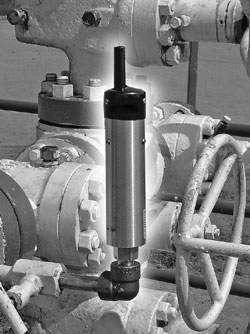 Technology from Europe: Technology from Europe:
United Kingdom
Compact wireless monitoring system tested
London-based Zencus International and Essex-based Radio-Tech have developed a new wireless wellhead monitoring system for the oil and gas industry. The Zencus system delivers remote, real-time wellhead and field production data to the desktop of field operators, engineers and managers.
 |
The new wireless system delivers remote, real-time wellhead and production data to the desktop.
|
|
A major constraint to installing real-time wellhead monitoring instrumentation is providing electrical power, cables and conduit at remote locations. The Zencus system overcomes this by integrating a sensor, low-power radio, a data-acquisition unit, a signal processor and a small, very power-efficient circuit with a long-life battery in a compact, water proof enclosure. The unit has low power consumption with a five-year battery life. It is ATEX, CE and FCC approved, is compact and sealed to IP68.
The system is formed from four components: the mono transmitter, field transmitter, field office receiver and data server, and the data visualization module. The mono transmitter is a compact device, 50 mm x 200 mm, that requires no structural support, wires, cables or conduit, since it is battery-operated. There are several sensor options including pressure, differential pressure, flow, level, temperature, pulse count and on/off sensors. The unit’s range is site and frequency dependent and can transmit from 100 to 1,000 m.
The field transceiver has four components: modem, CPU, transmitter and power supply. Power is provided from a solar panel and battery pack with a power management system. The modem can handle signals from up to 100 mono transmitters and the transmitter can communicate out 35 km and over longer distances using repeater stations.
The field office receiver and data server can be configured to the client’s requirements. The base radio modem receiver feeds the data server, which can be linked to third-party data historians over the Internet. The field office can link to multiple field transceivers for unlimited data acquisition and redundancy. It can handle local visualization, intelligent alarming and diagnostic functions.
The data visualization module is fully web-enabled to deliver real-time field data to the oil company. Access is password protected, but provides corporate-wide access. Capabilities include data reduction, analysis and trend functions. Data tables can be exported in Excel format for third parties.
Presently, most pressure, temperature and flowrate monitoring at the wellhead is done by personnel. The system is ideal for retrofitting brownfield sites as well as new field installations, and has had successful pilot trials with the state oil companies of Mexico, Qatar and Abu Dhabi. 
|

 Technology from Europe:
Technology from Europe:

